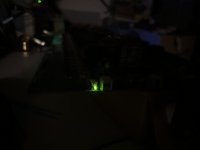In 1/2 protect, are the outputs of US3 still very near 0v?
With the black probe on the ground terminal of the PS driver board, what is the DCV on the anode of the protect LED?
On the cathode of the LED?
With the black probe on the ground terminal of the PS driver board, what is the DCV on the anode of the protect LED?
On the cathode of the LED?
US3 pins 1, 4, 7 are/are close to 0v (all below 0.1v, read at black probe primary ground)
Anode is 0.16v
Cathode is 0v
All read in half protect
Anode is 0.16v
Cathode is 0v
All read in half protect
I am 100% sure it is not
I have seen it on with no lights in the room before, and i hear a very slight change in fan speed when it goes into half protect.
Also it buzzes most of the time in normal idle and the buzzing goes away in half protect.
I have seen it on with no lights in the room before, and i hear a very slight change in fan speed when it goes into half protect.
Also it buzzes most of the time in normal idle and the buzzing goes away in half protect.
9 and 10 showed the same for everything on both chips
Chip circled in red showed only some noise in normal idle
Half protect showed some oscillation of some sort
Circled in blue showed nothing in half protect but I’m also not sure if I was properly making contact with it
Chip circled in red showed only some noise in normal idle
Half protect showed some oscillation of some sort
Circled in blue showed nothing in half protect but I’m also not sure if I was properly making contact with it
Attachments
Last edited:
Do you see excessive noise on the B+ or remote terminal of the PS driver board?
To check this, solder a short piece of wire to the ground terminals of the driver board and use the short grounding lead that clips onto the end of your scope probe to connect that that short wire. Don't let it move around to contact anything else. Then probe B+ and remote (and any other pins) to see if one is noisy.
Check these as the amp goes from normal operation into protect.
To check this, solder a short piece of wire to the ground terminals of the driver board and use the short grounding lead that clips onto the end of your scope probe to connect that that short wire. Don't let it move around to contact anything else. Then probe B+ and remote (and any other pins) to see if one is noisy.
Check these as the amp goes from normal operation into protect.
Do you see excessive noise on any of those terminals?
Why don't you want to solder? You can do it from the top.
Why don't you want to solder? You can do it from the top.
I don't need to worry about this thread closing due to inactivity right? Since the last post I have been busy through the last few weeks of my classes and haven't had time to continue troubleshooting the amp. I will be able to begin again in a few weeks though.
I like to avoid soldering if I can as I do not wish to screw anything up by accident but I could if necessary.
I like to avoid soldering if I can as I do not wish to screw anything up by accident but I could if necessary.
This is what normal idle vs half protect LEDs look like. Full protect turns off power LED and protect LED shines brighter
Also I heard dirty pre-amp filter knobs and buttons could cause an issue like this, is that true?
I can check all PS card terminals with the scope and multimeter soon if that would be helpful?
Also I heard dirty pre-amp filter knobs and buttons could cause an issue like this, is that true?
I can check all PS card terminals with the scope and multimeter soon if that would be helpful?
Attachments
Did you ever try installing a capacitor between the terminals on the driver board to reduce the noise to see if that made a difference?
I don't think the preamp noise could cause this.
I don't think the preamp noise could cause this.
- Home
- General Interest
- Car Audio
- 2 Monoblock Class Ds Not Working, I'm Lost



